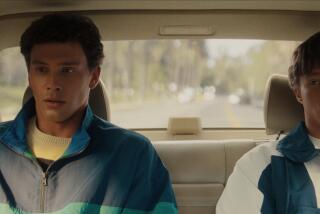Giants Under the Skin : CAPTIVITY CAPTIVE <i> by Rodney Hall (Farrar, Straus & Giroux: $15.95; 214 pp.) </i>
A microscope turns our blood corpuscles into tropical ferns, our fingerprints into mountain ranges, our hairs into stalactites. Even a simple magnifying glass tells us that we are giants; under a high-powered electronic instrument, we become galaxies.
Rodney Hallâs âCaptivity Captiveâ is just such an instrument. In an outback settlement in Australiaâs New South Wales, he has taken a family and its passions, and enlarged them. His Murphys are enormous. Daniel Murphy, the patriarch, is 6 feet 10; his wife is only two inches shorter, and they have 10 children.
Everything else about the family is outsized: its violence, its labors, its picnics, its love and hatred; and above all, the bonding and unbonding and the lurching shifts of power that make the interior of any family a tectonic convulsion.
But Hallâs purpose, in a book built around an incident of incest and triple murder, is not really to provide the epic story that all this implies. (It does sound rather like the embossed cover of a bodice-ripper.)
His purpose is to change our lenses. He tells a little story big. He suggests that the passions of any family can only be understood under magnification, and that our domestic aches, voids and horrors are the work of giants inside. We fall ill with little germs that can kill us; medicineâs and Hallâs instruments show us their dragon fangs and claws.
âCaptivityâ is narrated by Patrick, one of the 10 children, now 80 years old. He lives with two octogenarian brothers, one of them crippled with a stroke, the other mentally crippled by their fatherâs beatings, and a brother-in-law. The four are sea-drift on the shore, testimony of a familyâs voyage and its shipwreck.
The shipwreck took place 60 years earlier. On the day after Christmas, three bodies were discovered in a field near the Murphy land. They were those of three of the children: Norah, 27, Ellen, 18, and Michael, 29. All three were bound; the women had been clubbed to death and appeared to have been raped; Michael had been shot as well as clubbed.
No perpetrator was ever found. The horror, augmented by the mystery, made a national scandal and later a local legend. It also shattered the self-contained world of the Murphys, whose cohesiveness, pride and violent energy had made them something of a buccaneer clan in the region. Hall conveys the flavor when he describes the family, stiff and tearless, riding up to view the bodies:
âSo we came, beggarly and majestic as the Middle Ages in our patched motley, the longbow of our pride strained tight and ready to let fly at the first fool to oppose our grandeur with the triviality of public tears.â
Patrick, short and slight among his huge brothers, lettered and reflective amid the familyâs tumultuous instinctiveness, was signaled out from childhood as the scribe. He alone was sent to study with the local priest. His father, who assigned labors and characters to the other children and fought to impose them violently over their equally violent recalcitrance, had given him the role of outsider and witness.
When he would try to speak after school of what heâd learned, he was squelched. Just because he had studied, âIt did not follow that I was at liberty to spread the muck around.â
Now, with the family dying out, he tells what he knows. His narrative is cryptic and devious. By turns, it is a flood of rhetoric and a suspiciously parched trickle. It is told painfully, skipping about in time, approaching revelation, turning away and returning. It can be hard to make out and sometimes, in its foggy vehemence, hard to put up with. Hall has wedded the obduracy and pain of his story to the style in which it is told. We get no easy ride.
At the end, we learn what happened in the bloody field, or most of it. It is a terrible story, a family story, and finally as much of a mystery as before it was told.
Because the point of the narrative and of the book is not the familyâs deaths but the familyâs life. A volcano erupted that night; a volcano that lets us see for a moment the turmoil that churns beneath the countryside.
Patrick--finally, no detached witness but part of the turmoil--wrestles with the mysteries of his familyâs existence. There is the fatherâs violence, capable of smashing one sonâs ribs and of chaining another, howling, to his bed. It is a violence indistinguishable from the will to create, to form the inert clay, to subdue the harsh farmland, to make a family different from any other. It is a violence indistinguishable from love.
And love, in the Murphy family, is violence, or a whole array of differing violences. It is the parentsâ will both to dominate the children and to resist them; it is the childrenâs will to resist their parents--and each other--and to dominate them.
The Murphys are monsters, in a sense, but enlarged only to demonstrate the minute motions of creation and destruction inherent in the very essence of what a family is. Life is made, fought and yielded by monstrous means that we try not to recognize, the author is saying. In a seemingly arbitrary aside, he links the massacre of the Murphy children with the family massacre that would take place throughout Europe a few years later; World War I, that is.
The switch is abrupt, unprepared and apparently hasty. Hallâs novel is told in a state of feverishness. The writing is often brilliant; there are descriptions of the bitter and beautiful landscape, and of the shocking burden of physical labor that are unforgettable.
There are also times when the knottiness, the sheer recalcitrance of the narration are excessive. Hall burns to make us see, and we do see; and from time to time, our eyes fill with smoke from his unruly fire.
More to Read
Sign up for Essential California
The most important California stories and recommendations in your inbox every morning.
You may occasionally receive promotional content from the Los Angeles Times.









